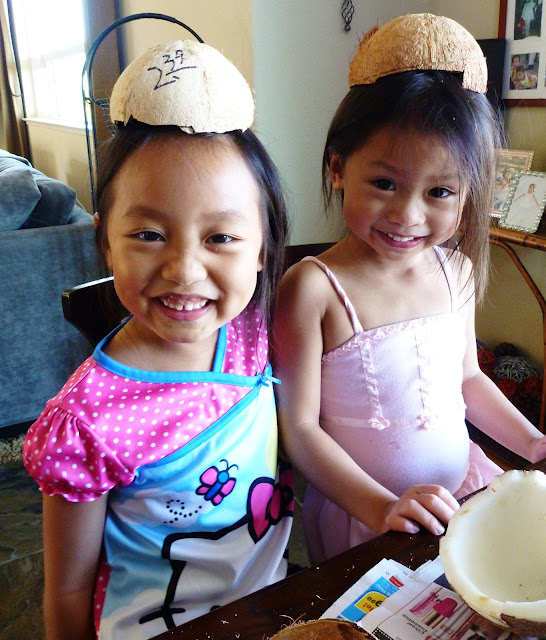RECIPE: Mứt Dừa
1. Lấy toàn thể 12 tháng trong năm đem rửa sạch mùi cay đắng, ghen tị, thù oán…rồi để cho ráo nước
2. Tuần tự cắt mỗi tháng ra 28, 30, hay 31 phần.
3. Trộn đều với : – Một chút tin yêu – Một chút kiên nhẫn – Một chút can đảm – Một chút cố gắng – Một chút hy vọng – Một chút trung thành
4. Ướp thêm gia vị: lạc quan, tự tin và hài hước
5. Rồi đem ngâm một lát trong dung dịch “Những điều tâm niệm của mình”.
6. Vớt ra, xây nhỏ, đổ tất cả vào “Nồi yêu thương” và nấu với lửa “Vui mừng”.
7. Đem ra ăn với “Nụ cười” trong chén “Bao dung”.
Oops...sorry! that wasn't the Mứt Dừa recipe but it's sure is a wonderful recipe isn't it? There is a few more recipes that I wanted to make for the Year of the Dragon but time is running out. Looks like Mứt Dừa will be the last post until next year.
Mứt Dừa wasn't on my Tet list until I saw coconuts at Bel Air. The other day, while we were at an Asian market, my younger daughter saw Mứt Dừa and wanted me to buy it for her. It seemed like all the Mứt are made in Vietnam. I hesitated to buy it as I've heard horrible stories about what goes in them. I promised that I will make Mứt Dừa for her instead. Today, my girls and I had so much fun prepping for Mứt Dừa. They were fascinated with the whole process of extracting the pulp from the coconut. First, the juice had to be drained by poking the eyes on the coconut. Next the shell was cracked and the coconut meat was pried from the shell. They had a blast being silly by wearing those shells on the heads.
We made four different colors using the beet extract for pink, turmeric powder for yellow, pandan extract for green and the coconut in its natural form for white. My favorite are the beautiful green and white coconut ribbons. The yellow coconut is just a little too yellow and pink is not as saturated as I had hoped. But my girls couldn't stop munching on these nutty, buttery, rich coconut ribbons coated with sugar.
*
RECIPE: Mứt Dừa
*
Ingredients
2 coconuts
2 cups sugar
1 bag vanilla sugar
1 tablespoon salt, for soaking the coconut ribbons
1 teaspoon beet juice, for red color, optional
(click here for natural beet coloring recipe)
1/2 teaspoon turmeric powder, for yellow color, optional
1/3 teaspoon pandan extract, for green color, optional
*
Preparing Coconut
Position a rack in the middle of the oven and preheat to 400 degrees.
Using an oyster knife or a screw driver pierce holes in 2 of the three eyes and pour out the juice.
You can use the coconut juice to make Thịt Trứng Kho Tàu or just drink it if it's sweet. Use a meat tenderizer or a hammer to crack the coconut open.
Put the coconut on baking sheet and bake 15 minutes. The heat will loosen the meat from the shell.
Remove coconut from oven. Holding it with a dish towel, use a small knife or an oyster knife to pry out the meat. Try to keep the pieces as large as possible.
Using a vegetable peeler, shave off the brown skin from the white coconut meat. Rinse the meat to remove any excess bits of brown skin. use a slicer or a sharp knife, slice or cut the meat into thin ribbons of at least 2 inches long. Keep coconut ribbons in salt and water bowl.
Rinse and drain coconut ribbons and set aside.
*
Mixing Coconut Ribbons
In a large bowl, combine coconut ribbons and the remaining ingredients and mix well.
Let it sit until sugar dissolved. If you want to make coconut ribbons in 4 different colors, divide the mixed coconut in a four separate bowls and mix the colors to your liking.
*
Simmering Coconut Ribbons
In a large pan, add ribbons and bring heat to high. When the sugar starts bubbling, reduce heat to low and simmer for about 30 minutes. Make sure to stir constantly to expose the ribbons evenly to the syrup. They will gradually become silvery and soften.
The ribbons will soon turn white, become dry looking and stiffen. Keep stirring. The sugar will first cling to the ribbons and then flake off in white, sandy bits. When the ribbons are covered by a dry, sandy sugar film, they are done.
Remove from the stove and let the coconut ribbons cool completely. Transfer them to an airtight container and discard the powdery sugar.
*
Presentation
Enjoy candied coconut ribbons with a cup of hot tea!
























































